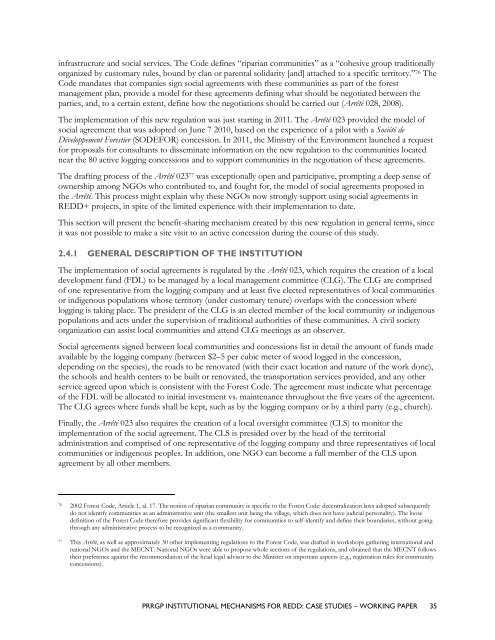Institutional Mechanisms for REDD+ - Case Studies Working Paper
Institutional Mechanisms for REDD+ - Case Studies Working Paper
Institutional Mechanisms for REDD+ - Case Studies Working Paper
Create successful ePaper yourself
Turn your PDF publications into a flip-book with our unique Google optimized e-Paper software.
infrastructure and social services. The Code defines ―riparian communities‖ as a ―cohesive group traditionally<br />
organized by customary rules, bound by clan or parental solidarity [and] attached to a specific territory.‖ 76 The<br />
Code mandates that companies sign social agreements with these communities as part of the <strong>for</strong>est<br />
management plan, provide a model <strong>for</strong> these agreements defining what should be negotiated between the<br />
parties, and, to a certain extent, define how the negotiations should be carried out (Arrêté 028, 2008).<br />
The implementation of this new regulation was just starting in 2011. The Arrêté 023 provided the model of<br />
social agreement that was adopted on June 7 2010, based on the experience of a pilot with a Société de<br />
Développement Forestier (SODEFOR) concession. In 2011, the Ministry of the Environment launched a request<br />
<strong>for</strong> proposals <strong>for</strong> consultants to disseminate in<strong>for</strong>mation on the new regulation to the communities located<br />
near the 80 active logging concessions and to support communities in the negotiation of these agreements.<br />
The drafting process of the Arrêté 023 77 was exceptionally open and participative, prompting a deep sense of<br />
ownership among NGOs who contributed to, and fought <strong>for</strong>, the model of social agreements proposed in<br />
the Arrêté. This process might explain why these NGOs now strongly support using social agreements in<br />
<strong>REDD+</strong> projects, in spite of the limited experience with their implementation to date.<br />
This section will present the benefit-sharing mechanism created by this new regulation in general terms, since<br />
it was not possible to make a site visit to an active concession during the course of this study.<br />
2.4.1 GENERAL DESCRIPTION OF THE INSTITUTION<br />
The implementation of social agreements is regulated by the Arrêté 023, which requires the creation of a local<br />
development fund (FDL) to be managed by a local management committee (CLG). The CLG are comprised<br />
of one representative from the logging company and at least five elected representatives of local communities<br />
or indigenous populations whose territory (under customary tenure) overlaps with the concession where<br />
logging is taking place. The president of the CLG is an elected member of the local community or indigenous<br />
populations and acts under the supervision of traditional authorities of these communities. A civil society<br />
organization can assist local communities and attend CLG meetings as an observer.<br />
Social agreements signed between local communities and concessions list in detail the amount of funds made<br />
available by the logging company (between $2–5 per cubic meter of wood logged in the concession,<br />
depending on the species), the roads to be renovated (with their exact location and nature of the work done),<br />
the schools and health centers to be built or renovated, the transportation services provided, and any other<br />
service agreed upon which is consistent with the Forest Code. The agreement must indicate what percentage<br />
of the FDL will be allocated to initial investment vs. maintenance throughout the five years of the agreement.<br />
The CLG agrees where funds shall be kept, such as by the logging company or by a third party (e.g., church).<br />
Finally, the Arrêté 023 also requires the creation of a local oversight committee (CLS) to monitor the<br />
implementation of the social agreement. The CLS is presided over by the head of the territorial<br />
administration and comprised of one representative of the logging company and three representatives of local<br />
communities or indigenous peoples. In addition, one NGO can become a full member of the CLS upon<br />
agreement by all other members.<br />
76 2002 Forest Code, Article 1, al. 17. The notion of riparian community is specific to the Forest Code: decentralization laws adopted subsequently<br />
do not identify communities as an administrative unit (the smallest unit being the village, which does not have judicial personality). The loose<br />
definition of the Forest Code there<strong>for</strong>e provides significant flexibility <strong>for</strong> communities to self-identify and define their boundaries, without going<br />
through any administrative process to be recognized as a community.<br />
77 This Arrêté, as well as approximately 30 other implementing regulations to the Forest Code, was drafted in workshops gathering international and<br />
national NGOs and the MECNT. National NGOs were able to propose whole sections of the regulations, and obtained that the MECNT follows<br />
their preference against the recommendation of the head legal advisor to the Minister on important aspects (e.g., registration rules <strong>for</strong> community<br />
concessions).<br />
PRRGP INSTITUTIONAL MECHANISMS FOR REDD: CASE STUDIES – WORKING PAPER 35

















